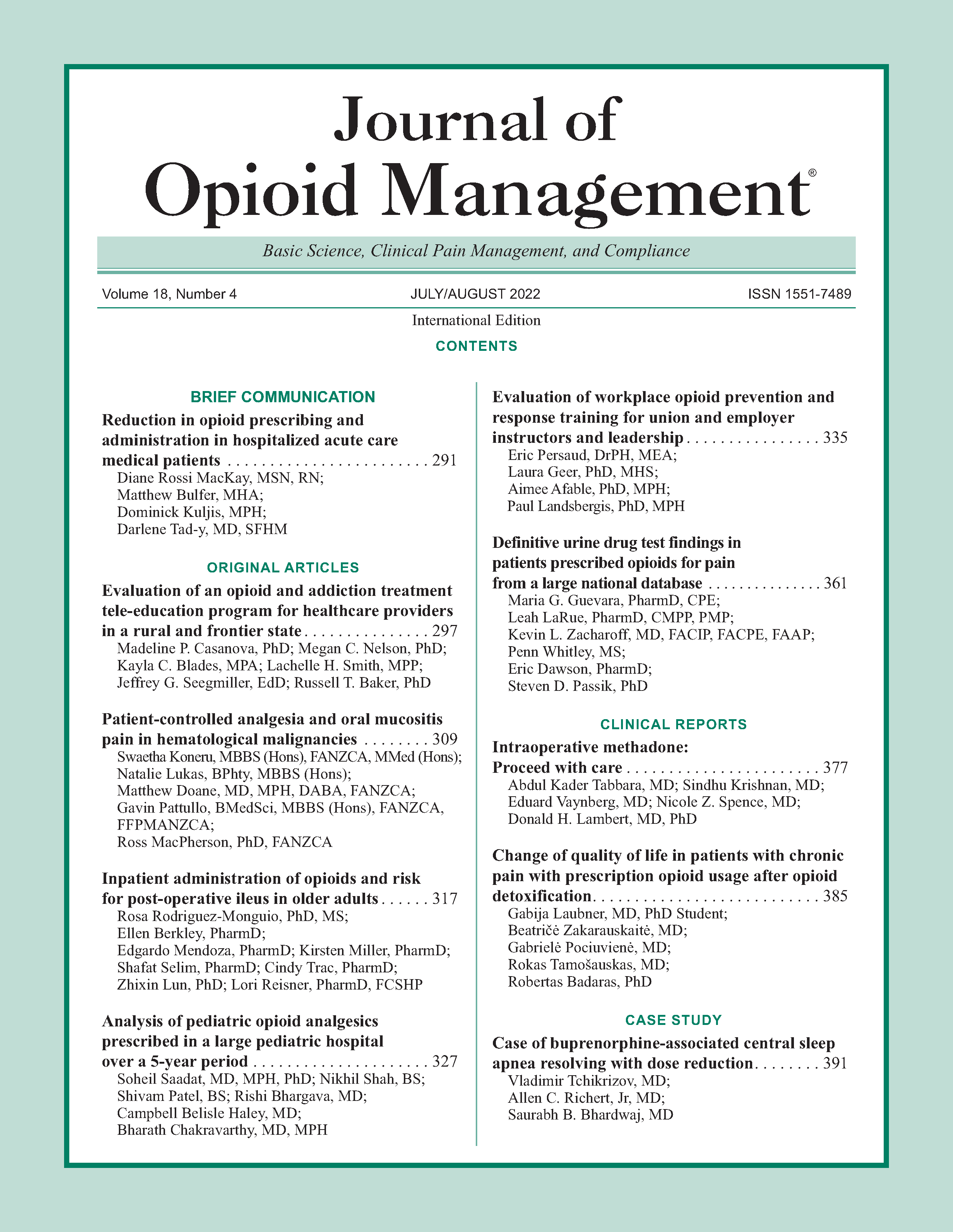Reduction in opioid prescribing and administration in hospitalized acute care medical patients
DOI:
https://doi.org/10.5055/jom.2022.0724Keywords:
opioid prescribing, alternatives to opioids, clinical pathways, hospitalized adultsAbstract
The Rocky Mountain Chapter of the Society of Hospital Medicine developed 2020 Opioid Prescribing and Treatment Guidelines for the medical inpatient, including five pathways for treating medical inpatients with pain. en Colorado hospitals participated in a 6-month initiative to implement the prescribing pathways, with an aim of reducing opioid prescribing by 15 percent for five commonly encountered medical conditions. Results showed 9.4 percent decrease in opioid morphine equivalent units, 3.4 percent reduction in opioid administrations, and 5.1 percent increase in alternatives to opioid administrations per patient day. Specialty-specific opioid prescribing guidance can help hospitalists change opioid prescribing behavior and should be considered in other specialties.
References
O’Donnell J, Gladden RM, Mattson CL, et al.: Characteristics of drug overdose deaths involving opioids and stimulants—24 states and the District of Columbia, January–June 2019. MMWR Morb Mortal Wkly Rep. 2020; 69(35): 1189-1197. DOI: 10.15585/mmwr.mm6935a1.
Whittington L: More Coloradans died of a drug overdose in 2019; fentanyl-related deaths spiked. 2020. Available at https://www.coloradohealthinstitute.org/research/more-coloradansdied-drug-overdose-2019-fentanyl-related-deaths-spiked. Accessed January 22, 2021.
Moride Y, Lemieux-Uresandi D, Castillon G, et al.: A systematic review of interventions and programs targeting appropriate prescribing of opioids. Pain Physician. 2019; 22(3): 229-240.
Duncan RW, Smith KL, Maguire M, et al.: Alternatives to opioids for pain management in the emergency department decreases opioid usage and maintains patient satisfaction. Am J Emerg Med. 2019; 37(1): 38-44. DOI: 10.1016/j.ajem.2018.04.043.
Herzig S, Mosher H, Calcaterra S, et al.: Improving the safety of opioid use for acute noncancer pain in hospitalized adults: A consensus statement from the society of hospital medicine. J Hosp Med. 2018; 13(4): 263-271. DOI: 10.12788/jhm.2980.
Dietsche MC, Esty ME, O’Neil MC, et al.: Opioid prescribing and treatment guidelines for the medical inpatient (Rocky Mountain Chapter of the Society of Hospital Medicine). 2020. Available at https://cha.com/wp-content/uploads/2020/08/SHM_Final.pdf. Accessed January 22, 2021.
Stader D, Wald H, Rossi MacKay D, et al.: Alternatives to opioid protocols in Colorado emergency departments reduce opioid use without changing reported pain. J Am Coll Emerg Physicians Open. 2020; 1(6): 1493-1499. DOI: 10.1002/emp2.12263.
del Portal DA, Healy ME, Satz WA, et al.: Impact of an opioid prescribing guideline in the acute care setting. J Emerg Med. 2016; 50(1): 21-27. DOI: 10.1016/j.jemermed.2015.06.014.
Busse JW, Sadeghirad B, Oparin Y, et al.: Management of acute pain from non–low back, musculoskeletal injuries: A systematic review and network meta-analysis of randomized trials. Ann Intern Med. 2020; 173(9): 730-738. DOI: 10.7326/M19-3601.
Hsu JR, Mir H, Wally MK, et al.: Clinical practice guidelines for pain management in acute musculoskeletal injury. J Orthopaed Trauma. 2019; 33(5): e158-e182. DOI: 10.1097/BOT.0000000000001430.
Published
How to Cite
Issue
Section
License
Copyright 2005-2024, Weston Medical Publishing, LLC
All Rights Reserved













